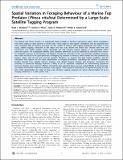Files in this item
Spatial variation in foraging behaviour of a marine top predator (Phoca vitulina) determined by a large-scale satellite tagging program
Item metadata
| dc.contributor.author | Sharples, Ruth Jemma | |
| dc.contributor.author | Moss, Simon | |
| dc.contributor.author | Patterson, Toby A | |
| dc.contributor.author | Hammond, Philip Steven | |
| dc.date.accessioned | 2012-09-19T11:31:02Z | |
| dc.date.available | 2012-09-19T11:31:02Z | |
| dc.date.issued | 2012-05-21 | |
| dc.identifier | 16741432 | |
| dc.identifier | 8b95c41c-66ca-4359-9c93-5bfccb22fc8c | |
| dc.identifier | 84861312445 | |
| dc.identifier.citation | Sharples , R J , Moss , S , Patterson , T A & Hammond , P S 2012 , ' Spatial variation in foraging behaviour of a marine top predator (Phoca vitulina) determined by a large-scale satellite tagging program ' , PLoS ONE , vol. 7 , no. 5 , e37216 . https://doi.org/10.1371/journal.pone.0037216 | en |
| dc.identifier.issn | 1932-6203 | |
| dc.identifier.other | ORCID: /0000-0002-2381-8302/work/47531596 | |
| dc.identifier.uri | https://hdl.handle.net/10023/3076 | |
| dc.description | The work was supported by the United Kingdom Department of Trade and industry, now the Department of Energy and Climate Change (http://www. decc.gov.uk/) through its Strategic Environmental Assessment programme (http://www.offshore-sea. .uk). The funders had no role in study design, data collection and analysis, decision to publish, or preparation of the manuscript. | en |
| dc.description.abstract | The harbour seal (Phoca vitulina) is a widespread marine predator in Northern Hemisphere waters. British populations have been subject to rapid declines in recent years. Food supply or inter-specific competition may be implicated but basic ecological data are lacking and there are few studies of harbour seal foraging distribution and habits. In this study, satellite tagging conducted at the major seal haul outs around the British Isles showed both that seal movements were highly variable among individuals and that foraging strategy appears to be specialized within particular regions. We investigated whether these apparent differences could be explained by individual level factors: by modelling measures of trip duration and distance travelled as a function of size, sex and body condition. However, these were not found to be good predictors of foraging trip duration or distance, which instead was best predicted by tagging region, time of year and inter-trip duration. Therefore, we propose that local habitat conditions and the constraints they impose are the major determinants of foraging movements. Specifically the distance to profitable feeding grounds from suitable haul-out locations may dictate foraging strategy and behaviour. Accounting for proximity to productive foraging resources is likely to be an important component of understanding population processes. Despite more extensive offshore movements than expected, there was also marked fidelity to the local haul-out region with limited connectivity between study regions. These empirical observations of regional exchange at short time scales demonstrates the value of large scale electronic tagging programs for robust characterization of at-sea foraging behaviour at a wide spatial scale. | |
| dc.format.extent | 759940 | |
| dc.language.iso | eng | |
| dc.relation.ispartof | PLoS ONE | en |
| dc.subject | Ecology | en |
| dc.subject | Harbour seal | en |
| dc.subject | QL Zoology | en |
| dc.subject | SDG 14 - Life Below Water | en |
| dc.subject.lcc | QL | en |
| dc.title | Spatial variation in foraging behaviour of a marine top predator (Phoca vitulina) determined by a large-scale satellite tagging program | en |
| dc.type | Journal article | en |
| dc.contributor.institution | University of St Andrews. School of Biology | en |
| dc.contributor.institution | University of St Andrews. Scottish Oceans Institute | en |
| dc.contributor.institution | University of St Andrews. Centre for Research into Ecological & Environmental Modelling | en |
| dc.contributor.institution | University of St Andrews. Marine Alliance for Science & Technology Scotland | en |
| dc.contributor.institution | University of St Andrews. Sea Mammal Research Unit | en |
| dc.identifier.doi | https://doi.org/10.1371/journal.pone.0037216 | |
| dc.description.status | Peer reviewed | en |
This item appears in the following Collection(s)
Items in the St Andrews Research Repository are protected by copyright, with all rights reserved, unless otherwise indicated.

